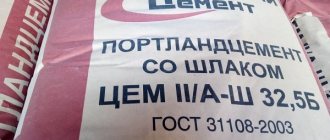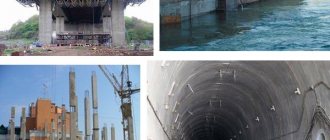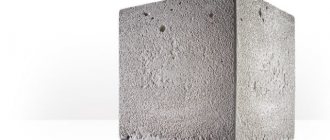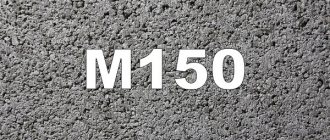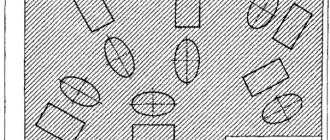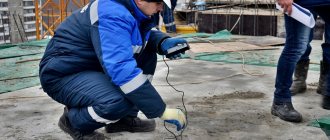When choosing a concrete mixture, everyone asks the question: “Which mixture is suitable for this project?” This is where the symbols for concrete come into play - a lot of letters and numbers that are incomprehensible at first glance. What do the letters and numbers mean in the description of the ready-mix concrete?
Many people have heard about the brands and classes of concrete. But, there are other characteristics that manufacturers indicate in the textures of their products: type of concrete, grades for workability, water resistance and frost resistance.
Each solution has individual characteristics and is used in certain areas of construction and repair. It is these unique properties that are indicated by a series of letters and numbers, and in order to navigate the properties, classes and grades of concrete, there are special tables with characteristics.
Concrete class
What does concrete class mean? Concrete class is a guaranteed compressive strength. What does it mean? Concrete during operation is subjected to loads of varying degrees - concrete for the foundation of a dacha and concrete in bridge supports are subject to radically different loads. The class of concrete means the permissible value of possible deterioration in quality, provided that the strength is equal to the specified one.
The strength of a concrete mixture depends on the ratio of water, sand, cement and other components, as well as on their quality, adherence to technologies in the concrete manufacturing process, the influence of external factors, laying conditions, hardening characteristics, etc. Similar concrete grades may have different strengths.
The strength of concrete is tested in special laboratories. To do this, during the production process, cubes of 15*15*15 cm are cast, which are left to harden for 28 days. When a cube of concrete is ready for a strength test, it is subjected to loads using special equipment. The results are measured and the concrete is assigned the appropriate class.
B is a letter indicating the class of concrete, the number next to it is the load value, measured in MPa. Concrete classes range from B3.5 to B80. The most popular are within B7.5 - B40. The lower the class, the less durable the concrete. The class is indicated in the construction design documents. It is important to correctly correlate the characteristics - there are special tables for this.
What does it represent?
When you need BSG concrete, the decoding of which indicates that it is a ready-made mixture, the customer needs to contact the manufacturer directly. In such cases, the company delivers the mixture using concrete mixer trucks. This is a technique equipped with appropriate equipment that allows you to maintain the solution in a certain state until it arrives at the site.
The composition of BSG is a mixture of classical ingredients - cement, sand, crushed stone, water. The proportions depend on what characteristics the final product should have. BSG may also contain special additives to improve the performance characteristics of the material.
The interpretation of BSG concrete means that the mixture is already ready, and the customer cannot control the process of its production. However, this does not mean that everything is left to chance. The entire production process is still controlled.
The company uses a recipe that meets GOST requirements for such mixtures. Concrete is made from high-quality raw materials, the ingredients are taken in precise proportions, which allows you to obtain a mixture with the specified characteristics, that is, its viscosity will meet the standards, and after hardening the mixture will turn into a monolith that can withstand all standard loads.
Concrete grade
If class is a characteristic of strength, then what is a brand?
The brand also indicates the strength of concrete, only measured in kgf/cm2. The brand is designated by the letter "M". The range of concrete grades is from M50 to M1000.
The difference between a grade and a concrete class is that the class is assigned after laboratory tests. The brand designates concrete produced according to a specific recipe with the expected compressive strength characteristics.
There is a table of correspondence between classes and grades of concrete with interpretation. Here we will indicate the areas of application of the most popular brands of concrete.
The grade of concrete depends mainly on the amount of cement in the mixture - the higher the value, the less the concrete hardens. When choosing a specific brand of concrete, they are guided by the type of future structure. For foundations or for road work, concrete grades M-100 and M-150 are mainly used.
M-200 is used for pouring the foundations of houses, supporting walls, constructing stairs, etc.
M-350 is used in monolithic construction, and concrete of higher grades is used for structures subject to large and constant dynamic loads. For example, it is used in the construction of dams, dams and other hydraulic structures.
Main advantages
BSG are used in various fields, both for the construction of residential buildings and for industrial construction. Of course, there are some brands of concrete that have specific characteristics and cannot be produced using such technologies, but in general, BSG is a fairly broad category of materials.
The explanation of BSG concrete turns out to be quite long. It is often called ready-mixed concrete. The main advantage is high quality. It is almost impossible to achieve such characteristics on a construction site. After all, to do this, you need to ensure the protection of all ingredients and fillers from contamination, stably maintain the set temperature, and achieve precise adherence to the dosage for each ingredient.
All of these are very difficult tasks. Not to mention the fact that you need to select high-quality basic ingredients from the very beginning and mix them in a certain sequence.
Concrete designation table
| Concrete strength class | The closest concrete grade in terms of strength | Application |
| B 3.5 | M 50 | |
| AT 5 | M 75 | |
| B 7.5 | M 100 | Preparatory work for pouring foundations. In road construction as a concrete cushion under curbs. |
| AT 10 | M150 | Floor screed, foundations for small structures, filling of paths in personal plots |
| At 12.5 | M 150 | |
| At 15 | M 200 | Various types of foundations (strip, slab), retaining walls, blind areas, stairs. One of the most popular concretes. |
| IN 20 | M 250 | The previous brand includes the production of fences and light-duty floor slabs. |
| At 22.5 | M 300 | Monolithic foundations, floor slabs, monolithic walls are added |
| At 25 | M 350 | Monolithic foundations, floor slabs, piles, road slabs, reinforced concrete products, swimming pool bowls. |
| At 27.5 | M 350 | |
| At 30 | M 400 | Hydraulic structures, bridges, specialized reinforced concrete products and structures. |
| At 35 | M 450 | Used in the construction of subways and dams. |
| At 40 | M 550 | It is rarely used and is produced according to specific requirements for each case. |
| At 45 | M 600 | |
| At 50 | M 700 | |
| At 55 | M 750 | |
| At 60 | M 800 | |
| At 65 | M 900 | |
| At 70 | M 900 | |
| At 75 | M 1000 | |
| At 80 | M 1000 |
Frost resistance
The frost resistance of concrete is also an important indicator. It reflects the number of cycles of freezing and subsequent thawing that a particular type of material can withstand without losing its performance characteristics or becoming deformed.
This indicator is indicated in the marking with the Latin letter F. The numbers after it show how many cycles the concrete will last.
For example, F50 - 50 cycles. It is logical to assume that 50 years means, but this is not so, only the cycles themselves are taken into account. Therefore, the higher the indicator, the better.
For areas with harsh winters, it is generally recommended to choose concrete with an index of at least F500 or even higher.
BST V25 P1 F200 W4 GOST 7473-2010—an example of the designation of a concrete mixture
What properties does this concrete have? What can it be used for? What brand is it?
Let's find answers to these questions and, using an example, consider the generally accepted designations of concrete.
Let's start from the end, with GOST. GOST is a list of STATE STANDARDS and symbols established for the production of a particular type of product. Currently, for the production of concrete, GOST 7473-2010 is in force , which is compiled taking into account European standards.
According to GOST, the type of concrete is indicated at the beginning:
- BST - concrete mixtures of heavy concrete;
- BSM - concrete mixtures of fine-grained concrete;
- BSL - concrete mixtures of lightweight concrete.
This is followed by an indication of the concrete strength class - letter “B”. This is a key indicator that you need to focus on when choosing and ordering a concrete mixture.
Concrete grade for workability
The next characteristic indicated in the description of the concrete mixture is the workability grade . The term workability means the ability of a mixture to take shape and form a homogeneous mass as a result of compaction. Workability is assessed by the parameters of mobility and rigidity. These parameters are determined using laboratory tests. But, if we briefly characterize them, mobility shows how easily the concrete mixture spreads and fills the form. Hardness is measured in the seconds required for a mixture to be compacted by vibration.
Based on workability grades, the following types of concrete mixtures are distinguished:
- mobile - indicated by the letter “P” and numbers from 1 to 5, while the higher the number, the more mobile the mixture;
- hard - “F”, range from 1 to 4, the higher the number, the higher the hardness of the mixture;
- super-hard mixtures - “SZh”, require more time for compaction and are marked with numbers 1-3.
Concrete grade for frost resistance
The workability characteristic is followed by frost resistance . This parameter indicates how many freeze/thaw cycles concrete can withstand without losing its qualities. The frost resistance class designation is the letter “F” and numbers from 50 to 1000 (number of cycles).
Concrete grade by water permeability
And the last parameter is water resistance , the ability of concrete not to allow moisture to pass through it. A very important indicator in the construction of hydraulic structures and underground communications. The designation is “W” with numbers from 2 to 20. The higher the number, the more pressure the concrete can withstand without letting water pass through it.
Let's return to our example and decipher what it means:
BST V25 P1 F200 W4 GOST 7473-2010
- BST - a mixture of heavy concrete was made;
- B25 – mixture class (grade M350);
- P1 – the mixture is inactive, has the lowest mobility index;
- F200 - the mixture can withstand up to 200 cycles of freezing and thawing;
- W4 – rather low water resistance;
- The mixture meets the requirements of GOST .
Concrete with similar characteristics is used for the manufacture of reinforced concrete products and the construction of monolithic foundations.
The characteristics of concrete are not only an indication of the brand or class. The wide range of applications of concrete necessitates the need to specify additional parameters. In private housing construction, for example, when building a foundation for a bathhouse, frost resistance or water resistance grades are not of great importance. But in the production of reinforced concrete products, industrial or road construction, such parameters play a decisive role.
Types of BSG
Several criteria are used to classify ready-mixed concrete. They are divided into groups depending on the aggregate used, the density of the cement, the structure of the material, as well as its strength.
From this point of view, there are:
- lightweight concrete;
- BSG concrete mixtures of heavy concrete, and they can be both ordinary and especially heavy;
- ready-made concrete for social purposes.
The choice of a specific variety depends on what tasks are set by the developer.
Mobility (P)
Workability is a marking of the workability of a concrete mixture, calculated by the cone settlement (GOST 7473-2010)
Roughly speaking, the mobility of concrete is the ability of the mixture to fill the form in which it is placed, the ability to spread and occupy the given volume.
Mobility is determined experimentally. The concrete mixture is poured into a cone 30cm high. After removing the cone, the amount of sediment is measured. If the shape has remained practically unchanged (settled by 1-5 cm), then such concrete is called rigid. It hardly changes shape, but is perfectly formed using vibration compactors. The mobility of such concrete is low, and its use is limited: such a concrete mixture is difficult to install into formwork of a certain shape. Mixtures with sediment from 6cm to 12cm are classified as plastic types.
Concrete mix mobility categories:
| Mobility of concrete mixture | Cone draft |
| Sedentary (P1) | 1 – 5 cm |
| Mobile (P2) | 5 – 10 cm |
| Highly mobile (P3) | 10 – 15 cm |
| Cast (P4) | 15 – 20 cm |
| Fluid (P5) | 21 or more |
Waterproof
The durability of the material is affected not only by its frost resistance, but also by its water resistance. The indicator is of particular importance for concrete, which is used when constructing foundations and laying foundations in the ground. It is designated by the Latin letter W and reflects the water pressure that the concrete can withstand.
This indicator is no less interesting for those who buy dry mixtures. Additionally, they have yet to prepare the concrete on site.
Those who buy BSG B20 W20 concrete do not need a recipe for this: the mixture is ready, all that remains is to use it for 2 hours so that it does not lose its properties.
What other mixtures are there?
Of course, for the convenience of buyers, manufacturers offer a wide variety of mixtures. It is not always convenient to deliver ready-made concrete directly to the site. Manufacturers often limit sales to a certain volume - at least 1 cubic meter of the mixture. That is, you can purchase the mixture in a different format and produce it directly on site in the required volume.
BST mixture
The meaning of the abbreviation is heavy concrete mixture. Its peculiarity is the use of a large number of heavy components as filler - crushed stone, gravel. The main characteristics of such heavy concrete directly depend on the characteristics of the filler. That is why they must be taken into account at the design stage of the structure, and the recipe for the future mixture is adjusted to the needs of the project.
The BST mixture is widely used - in the construction of industrial buildings, high-rise buildings, construction of road surfaces, hydraulic structures, etc. Heavy concrete is considered a universal building material.
BSM mixture
Explanation BSM - fine-grained concrete mixture. Another name is sand concrete. From the name it is clear that the proportion of sand in this composition is increased. Here it completely replaces coarse filler - crushed stone, gravel. The main binding component is cement with a high alite content - tricalcium silicate, which has a high density.
The finished mixture is dense and is used for the manufacture of products with frequent reinforcement. In addition, the mobile mixture is used to fill expansion joints and cracks.
